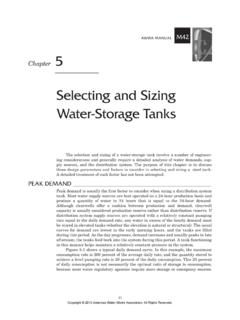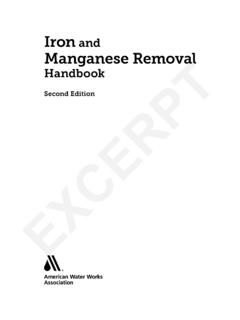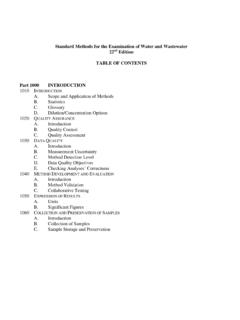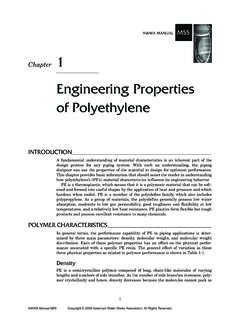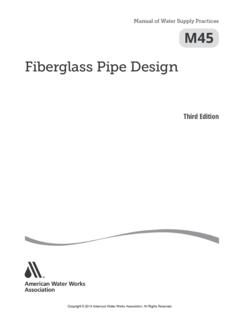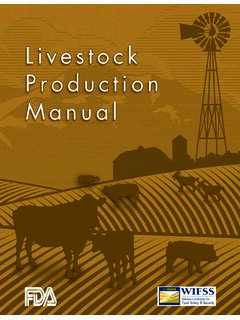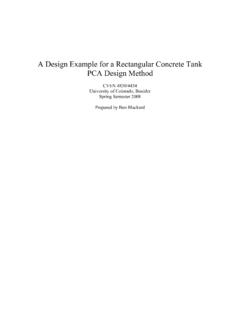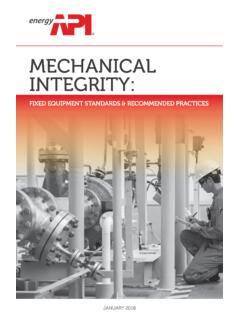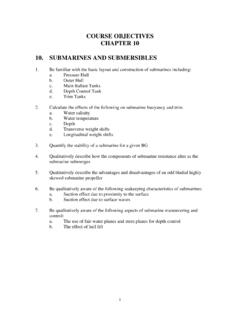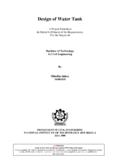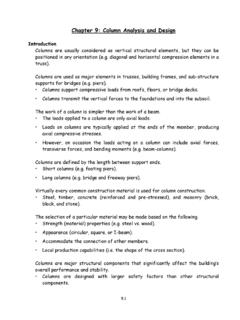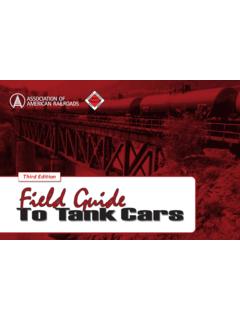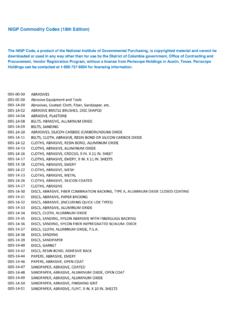Transcription of Steel Water-Storage Tanks
1 Steel Water-Storage TanksAWWA MANUAL M42 Revised EditionCopyright 2013 American water Works Association. All Rights of Figures, vii List of Tables, xi Preface, xiii Acknowledgments, xv Introduction, xvii Definitions, xviii AWWA Standards, xviii Welded Tanks , xix Bolted Tanks , xxComposite Elevated Tanks , xxPart I Elements of Steel water Tanks 1 Chapter 1 Typical Capacities and Configurations..3 Reservoirs, 3 Standpipes, 3 Roof Designs for Reservoirs and Standpipes, 10 Elevated Tanks , 12 Multiple-Column Elevated Tanks , 13 Pedestal Elevated Tanks , 18 Chapter 2 Appurtenances..29 Shell Manholes, 29 Pipe Connections, 30 Overflow, 32 Ladders and Safety Devices, 33 Roof Openings, 36 Vents, 37 Devices for Indicating water Level, 39 Emergency Fill/Withdraw Connections, 40 Chapter 3 Cathodic Protection.
2 41 Nature of Corrosion, 41 Principles of Cathodic Protection, 43 Cathodic Protection Design, 44 Maintenance, 45 Chapter 4 Coating Systems ..49 Interior Coatings, 49 Exterior Coatings, 51 Inspection and Quality Control, 52 Removing Coating by Abrasive Blasting, 52 iiiCopyright 2013 American water Works Association. All Rights II The New Tank Project 55 Chapter 5 Selecting and Sizing Water-Storage Tanks ..57 Peak Demand, 57 Fire Flow, 58 Top and Bottom Capacity Levels, 58 water Quality Issues, 58 Energy Costs, 60 Future Needs, 60 Environmental Impact, 60 Tank Costs, 60 Chapter 6 Construction Considerations ..63 Design Standards, 63 Contract Documents, 64 Constructor Capabilities, 64 Guarantees, 64 Soil Investigations, 64 Reservoir and Standpipe Foundations, 67 Elevated Tank Foundations, 69 Tank Site, 69 Tank Coating: Welded Steel Tanks , 71 Tank Coating: Bolted Steel Tanks , 73 Tank water Testing and Disinfection, 73 Engineer s Role, 73 Bidding Documents, 74 Chapter 7 Inspecting New Tank Construction.
3 77 Responsibility for Quality, 77 The Foundation, 78 Fabrication, 80 Steel Delivery, 80 Tank Erection, 80 Field Cleaning and Coating, 83 Mechanical and Electrical Appurtenances, 85 Part III Existing Tanks 87 Chapter 8 Routine Operation and Maintenance..89 Energy Management, 89 Controls, 90 Periodic Operator Inspection, 90 Tank Washouts, 92 Chapter 9 Professional Examination and Renovation ..95 Tank Maintenance Engineer s Functions and Qualifications, 96 Pre-Bid Inspection, 98 Preparing Specifications, 103 Monitoring the Constructor s Progress, 105 Periodic Reinspection, 108 Copyright 2013 American water Works Association. All Rights 10 Cold-Weather Operation ..109 Causes and Results of Freezing, 109 Data Related to Freezing, 112 Designing Tanks for Cold Weather, 112 Cold-Weather Operating Procedures, 117 Systems to Prevent Freezing, 119 Dealing With Frozen Tanks , 121 Appendix A Bibliography.
4 123 Appendix B Steel water Tank Industry Standards ..125 Appendix C ANSI/AWWA D101-53 (R86), Inspecting and Repairing Steel water Tanks , Standpipes, Reservoirs, and Elevated Tanks for water storage ..131 Index 141 AWWA List of Manuals 147 Copyright 2013 American water Works Association. All Rights than 100,000 Steel Water-Storage Tanks have been constructed within the last 100 years, a value that far exceeds the number of large Water-Storage vessels of any other type of construction material. Many Steel water Tanks have service histories in excess of a century and are still in service today (Figure F-1). Whereas early Tanks were riveted, modern practice uses welded or bolted design and construction, which provide the advantage of a zero leakage tolerance.
5 To further increase their potential service life, Steel Tanks can be dismantled and re-erected in new locations. A tank that was originally in an optimal location can become useless if a factory relocates or there is a shift in housing patterns. However, a Steel tank can be dismantled and then erected and coated at a new location. This manual provides information on the selection, design, construction, maintenance, inspection, and repair of Steel Tanks for potable water storage . The manual will assist in tank sizing, configuration, site selection, design, operation, and maintenance. IntroductionFigure F-1 A tank constructed in 1902 is still serving Wabash, Ind.
6 , with practically no metal lossSource: Tank Industry Consultants 2013 American water Works Association. All Rights _____The following definitions apply in this manual: Bottom capacity level (BCL) The water level in the tank when the tank is emptied through the specified discharge fittings (unless otherwise specified by the pur-chaser). In an elevated tank, the elevation of the bottom capacity level(s) is as given by the purchaser and is determined by the design features of the tank configuration. Capacity The net volume in gallons (liters) that may be removed from a tank emptied to its bottom capacity level after being filled to its top capacity level. Constructor The party that furnishes the work and materials for placement and installation.
7 Elevated tank A container or storage tank supported on one or more columns. Engineer An employee of the purchaser or, more commonly, a professional en-gineering firm engaged by the purchaser to perform specification and inspection ser-vices. Head range The difference between the lower and upper capacity levels of a tank. Manufacturer The person or company that furnishes the tank components. Owner The person or firm that will own and operate the completed tank. The owner may designate agents, such as an engineer, purchaser, or inspector, for specific project responsibilities. Purchaser The person, company, or organization that purchases the tank. Reservoir A ground-supported, flat-bottom cylindrical tank with a shell height less than or equal to its diameter.
8 Standpipe A ground-supported, flat-bottom cylindrical tank with a shell height greater than its diameter. Tank An elevated tank, standpipe, or reservoir used for water storage . Top capacity level (TCL) The maximum operating level of water in a tank, as dictated by the elevation at which water discharges from the tank through the over-flow pipe entrance. In a standpipe or reservoir, the top capacity level is as given by the purchaser. In an elevated tank, the elevation of the top and/or bottom capacity level(s) is as given by the purchaser. AWWA STANDARDS _____The majority of all Steel potable Water-Storage Tanks constructed in the United States adhere to specifications that reference the following American water Works Association (AWWA) Steel tank standards: ANSI/AWWA D100, Standard for Welded Carbon Steel Tanks for water storage .
9 ANSI/AWWA D102, Standard for Coating Steel Water-Storage Tanks . ANSI/AWWA D103, Standard for Factory-Coated Bolted Carbon Steel Tanks for water storage . ANSI/AWWA D104, Standard for Automatically Controlled, Impressed- Current Cathodic Protection for the Interior Submerged Surfaces of Steel water storage Tanks . ANSI/AWWA D106, Standard for Sacrificial Anode Cathodic Protection Systems for the Interior Submerged Surfaces of Steel water storage Tanks . Copyright 2013 American water Works Association. All Rights ANSI/AWWA D107, Standard for Composite Elevated Tanks for water storage . ANSI/AWWA D108, Standard for Aluminum Dome Roofs for water storage Facilities.
10 ANSI/AWWA C652, Standard for Disinfection of Water-Storage Facilities. These standards (except ANSI/AWWA C652) are developed and maintained under the direction of the AWWA Standards Committee on Steel Elevated Tanks , Standpipes, and Reservoirs, which is composed of members representing consumer (utility), general interest (academic and consulting engineering), and producer (con-structor and manufacturer) groups. ANSI/AWWA C652 was developed and is main-tained by the AWWA Standards Committee on Disinfection of Facilities. Once a draft standard or revision is approved by a standards committee, it is forwarded to the AWWA Standards Council for review and approval.
